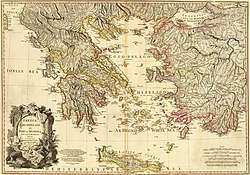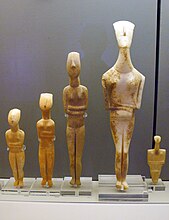Cycladic culture
| |||||||||||||||||||||||||||||||||||||||||||||||||||||||||||||||||||||||||||||||
Read other articles:

Archaeological site Qesem caveמערת קסםQesem CaveShown within IsraelLocationCentral District, near the town of Kafr QasimHistoryPeriodsLower Paleolithic Qesem cave is a Lower Paleolithic archaeological site near the town of Kafr Qasim in Israel. Early humans were occupying the site by 400,000 until c. 200,000 years ago. The karstic cave attracted considerable attention in December 2010, when reports suggested Israeli and Spanish archaeologists had found the earliest evidence yet of …

MuftiAbdur Rahmanআব্দুর রহমান চাটগামীPersonalBornAbdur Rahman1920Imam Nagar, Fatikchhari, Chittagong District, Bengal Presidency, British IndiaDied10 November 2015(2015-11-10) (aged 94–95)Dhaka, BangladeshReligionIslamNationalityBangladeshiRegionBangladeshDenominationSunniJurisprudenceHanafiMovementDeobandiMain interest(s)Islamic economics, Hadith, Islamic jurisprudenceMuslim leaderTeacherSultan Ahmad Nanupuri Influenced by Azizul Haq Abdur Rahman …

غيم بويالشعارمعلومات عامةالماركة نينتندو النوع منصة ألعاب فيديو محمولة يدوياالصانع نينتندو المطور نينتندو للبحث والتطوير 1 عائلة المنتج خط إنتاج الغيم بويالجيل الجيل الرابعالسعر المبدئي 89٫95 دولار أمريكي المبيعات عالمياً: 118.69 مليون وحدة ، مع جهاز الغيم بوي كولرأهم التوار�…

Серия телесериала «Чёрное зеркало»Бросок гадюкиStriking Vipers Основная информация Номер серии Сезон 5Серия 1 Режиссёр Оуэн Харрис Автор сценария Чарли Брукер Дата выхода 5 июня 2019 года Длительность 61 минута Приглашённые актёры Энтони Маки — Дэнни Паркер Яхья Абдул-Матин I…

Mine located in Papua in Indonesia For the German municipality, see Grasberg. Grasberg mineGrasberg mine open pit, 2007LocationGrasberg mineLocation in Central PapuaShow map of Central PapuaGrasberg mineLocation in IndonesiaShow map of IndonesiaGrasberg mineLocation in New GuineaShow map of New GuineaLocationMimika RegencyProvinceCentral PapuaCountryIndonesiaCoordinates4°3′10″S 137°6′57″E / 4.05278°S 137.11583°E / -4.05278; 137.11583ProductionProducts Copper G…

STOS BASICLoading screenDeveloperFrançois Lionet, Constantin SotiropoulosFirst appeared1988; 36 years ago (1988)Influenced byBASICInfluencedAMOS STOS BASIC is a dialect of the BASIC programming language for the Atari ST personal computer. It was designed for creating games, but the set of high-level graphics and sound commands it offers is suitable for developing multimedia software without knowledge of the internals of the Atari ST. STOS BASIC was developed by Jawx–Fra…

西維珍尼亞 美國联邦州State of West Virginia 州旗州徽綽號:豪华之州地图中高亮部分为西維珍尼亞坐标:37°10'N-40°40'N, 77°40'W-82°40'W国家 美國加入聯邦1863年6月20日(第35个加入联邦)首府(最大城市)查爾斯頓政府 • 州长(英语:List of Governors of {{{Name}}}]]) • 副州长(英语:List of lieutenant governors of {{{Name}}}]])吉姆·賈斯蒂斯(R)米奇·卡邁克爾(英�…
2020年夏季奥林匹克运动会波兰代表團波兰国旗IOC編碼POLNOC波蘭奧林匹克委員會網站olimpijski.pl(英文)(波兰文)2020年夏季奥林匹克运动会(東京)2021年7月23日至8月8日(受2019冠状病毒病疫情影响推迟,但仍保留原定名称)運動員206參賽項目24个大项旗手开幕式:帕维尔·科热尼奥夫斯基(游泳)和马娅·沃什乔夫斯卡(自行车)[1]闭幕式:卡罗利娜·纳亚(皮划艇)[2…

Дендрологічний парк Харківського національного аграрного університету ім. В.В. Докучаєва План дендропарку1 травня 2013План дендропарку1 травня 2013 49°53′30″ пн. ш. 36°27′12″ сх. д. / 49.89166667002777444° пн. ш. 36.4536111100277722° сх. д. / 49.89166667002777444; 36.4536111100277722Коор�…

习近平 习近平自2012年出任中共中央总书记成为最高领导人期间,因其废除国家主席任期限制、开启总书记第三任期、集权统治、公共政策与理念、知识水平和自述经历等争议,被中国大陸及其他地区的民众以其争议事件、个人特征及姓名谐音创作负面称呼,用以恶搞、讽刺或批评习近平。对习近平的相关负面称呼在互联网上已经形成了一种活跃、独特的辱包亚文化。 权力類 �…

رسم توضيحي لنموذج الكواكب الذرية: الالكترونات بالأخضر والنواة بالأحمر. نموذج رذرفورد هو نموذج تصوري لتركيب الذرة صاغه العالم إرنست رذرفورد، بعد أن كلف مساعديه هانز جايجر إنست ماريسدن في العام 1909 بإجراء تجربة رقاقة الذهب الشهيرة في جامعة مانشستر، ثم أجرى رذرفورد دراسات تحل�…

Ruined mansion in Aberdeenshire, Scotland Ury House viewed across the Cowie Water The main front of Ury House. Ury House is a large ruined mansion in Aberdeenshire, Scotland, built in the Elizabethan style in 1885 by Sir Alexander Baird, 1st Baronet. It is situated on the north-east coast about 1 mile (1.6 km) north of Stonehaven in the former county of Kincardineshire. Prehistory Bronze Age cists have been found at the site of the Ury House. Roman legions marched from Raedykes to Normandyk…

「アメリカ」と「USA」はこの項目へ転送されています。その他の用法については「アメリカ (曖昧さ回避)」、「USA (曖昧さ回避)」をご覧ください。 この記事は英語版の対応するページを翻訳することにより充実させることができます。(2022年3月)翻訳前に重要な指示を読むには右にある[表示]をクリックしてください。 英語版記事を日本語へ機械翻訳したバージョン(Go…

Lumen fideiLatin: Terang ImanSurat ensiklik dari Paus Fransiskus Tanggal29 Juni 2013ArgumenTentang imanHalaman88Nomor ensiklik1 dari 2 dari kepausanNaskahDalam LatinDalam bahasa Inggris←Caritas in veritate Laudato si'→ Lumen fidei (bahasa Inggris: Terang Iman) adalah ensiklik pertama Paus Fransiskus, yang dikeluarkan pada 29 JUni 2013, Solemnitas Santo Petrus dan Paulus, dan dipublikasikan pada 5 Juli 2013, kurang dari empat bulan setelah ia terpilih menjadi Sri Paus. Ensiklik tersebut d…

هذه المقالة عن المملكة الأردنية الهاشمية. لمعانٍ أخرى، طالع الأردن (توضيح). الأردن المملكة الأردنية الهاشمية الأردنعلم المملكة الأردنية الهاشمية الأردنشعار المملكة الأردنية الهاشمية الشعار الوطنيالله، الوطن، الملك النشيد: السلام الملكي الأردنيالسلام الملكي ال�…

AbbiategrassocomuneCittà di Abbiategrasso Abbiategrasso – VedutaIl castello visconteo LocalizzazioneStato Italia Regione Lombardia Città metropolitana Milano AmministrazioneSindacoFrancesco Cesare Nai (centro-destra) dal 26-6-2022 TerritorioCoordinate45°24′03.24″N 8°55′06.6″E45°24′03.24″N, 8°55′06.6″E (Abbiategrasso) Altitudine120 m s.l.m. Superficie47,78 km² Abitanti32 688[1] (31-3-2024) Densità684,14 ab./km² Fraz…

Artikel ini sebatang kara, artinya tidak ada artikel lain yang memiliki pranala balik ke halaman ini.Bantulah menambah pranala ke artikel ini dari artikel yang berhubungan atau coba peralatan pencari pranala.Tag ini diberikan pada Januari 2023. Vera&John adalah kasino online yang berpusat di Malta. Vera&John dioperasikan oleh Dumarca Gaming Ltd, yang perusahaan induknya, Dumarca Holdings PLC, diakuisisi oleh Intertain Group Ltd pada tahun 2015.[1] Intertain Group Ltd terdaftar da…

See also: List of political parties in Australia and List of local government political parties in Australia § Former parties This is a list of historical political parties in Australia. These parties are no longer registered or active at a federal, state or federal level. Historical names of defunct and current parties are not included in the list as they are not separate entities. Major parties Federal parliamentary parties Political party Period Main ideology Position Political alliance…

Peta Kabupaten Bantaeng di Sulawesi Selatan Berikut adalah daftar kecamatan dan kelurahan di Kabupaten Bantaeng, Provinsi Sulawesi Selatan, Indonesia. Kabupaten Bantaeng terdiri dari 8 Kecamatan, 21 Kelurahan dan 46 Desa dengan luas wilayah 395,83 km² dan jumlah penduduk sebesar 196.358 jiwa dengan sebaran penduduk 496 jiwa/km².[1][2] Daftar kecamatan dan kelurahan di Kabupaten Bantaeng, adalah sebagai berikut: Kode Kemendagri Kecamatan Jumlah Kelurahan Jumlah Desa Status Dafta…

This article does not cite any sources. Please help improve this article by adding citations to reliable sources. Unsourced material may be challenged and removed.Find sources: Čata – news · newspapers · books · scholar · JSTOR (August 2016) (Learn how and when to remove this message) Location of Levice District in the Nitra Region Čata (Hungarian: Csata) is a village and municipality in the Levice District in the Nitra Region of south-west Slovakia. Hi…








